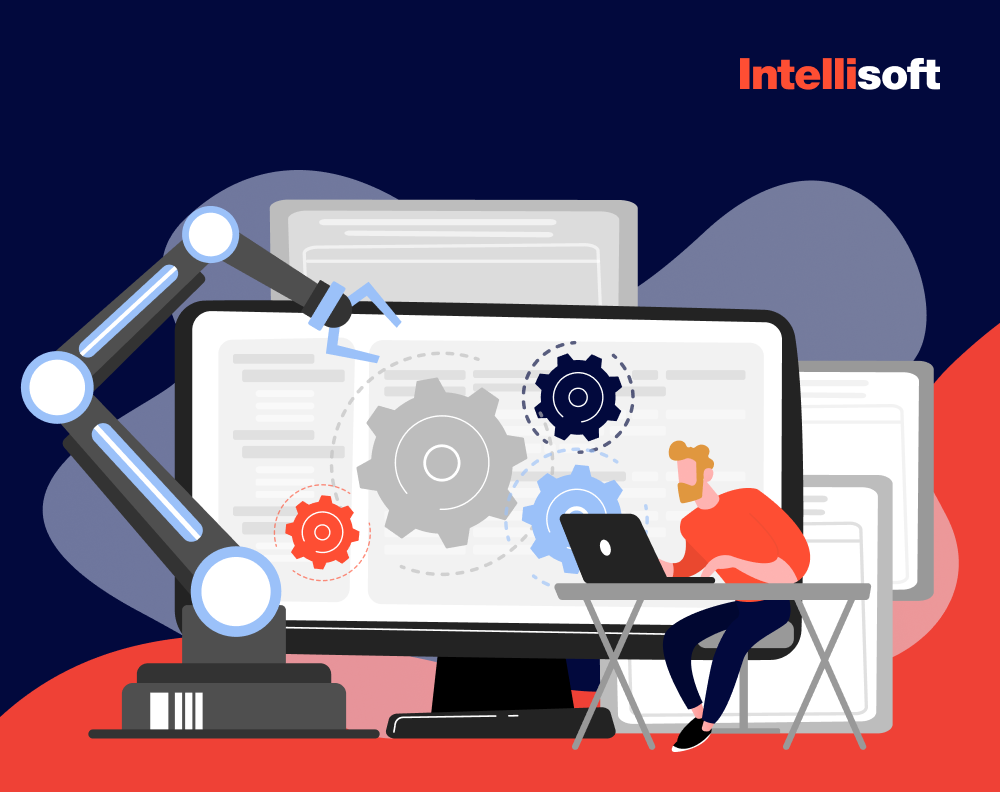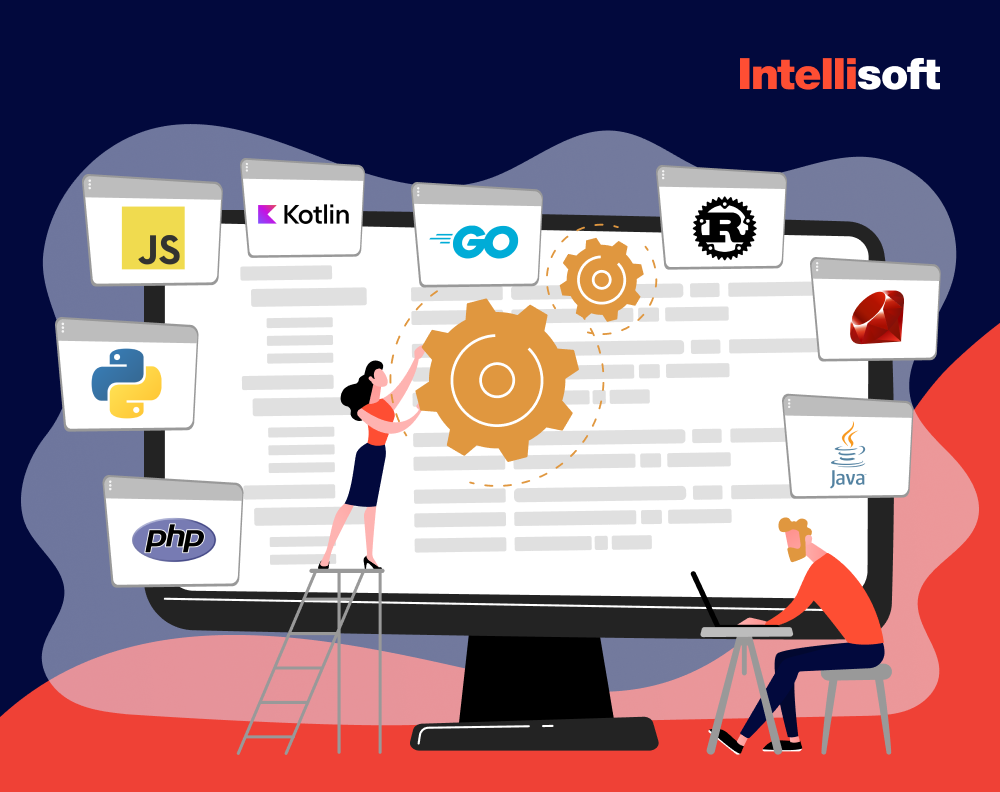Regarding software development, having skilled developers and advanced technology is not enough. A solid and comprehensive software development plan is needed to ensure the success of any project. This plan is a strategic roadmap that aligns resources, budget, and timelines, mitigating potential risks and providing a seamless journey from the concept to the execution stage.
In this article, we will guide you through creating a software development plan from scratch. We will delve into fundamental knowledge, provide a step-by-step guide, and share best practices you can follow. Additionally, we will offer a popular software development plan template that you can use to ensure that your project succeeds. Let’s dive in and get started!
Table of Contents
What Is A Software Development Plan?
An SDP Software Development Plan is a crucial strategic tool that delineates the entire Software Development Life Cycle (SDLC). This plan encompasses the project’s objectives, the resources at disposal, the budget, and the timeline, all crucial for facilitating an efficient development process, managing resources effectively, preventing risks, controlling costs, and ensuring the successful delivery of software.
A meticulously crafted project plan for software development is vital as it establishes a solid groundwork for seamless development activities and serves as a conduit between the development teams and stakeholders. This strategy ensures alignment and clear communication regarding the project’s requirements and timelines. Conversely, the absence of a structured plan in a development project can result in delays, cost escalations, and overall disarray.
A thorough Software Development Life Cycle project plan incorporates several essential elements:
- Project goals and requirements. Get a clear understanding of its purpose, target audience, and desired outcomes.
- Timeline and milestones. Create a detailed software development business plan with precise milestones to provide a clear project roadmap for everyone.
- Allocation of roles and responsibilities. Define each team member’s roles, responsibilities, and tasks to establish a culture of accountability and collaboration.
- Budget. Estimate costs associated with development, including expenses for resources and any other associated expenses.
Why Is a Software Development Plan Important?
Agile is a popular approach that helps ship and continuously iterate on a product. However, it is essential to have a plan in place to ensure that your work is completed within a specified timeframe. Even during the iterative process, your project must have a clearly defined start and end date. Additionally, someone on your team should always monitor the bigger picture to track your progress towards your goals.
Using a Gantt chart to outline your Agile software development project plan can be immensely helpful. It ensures you do not overlook significant milestones (such as approval or launch dates) and account for dependencies between tasks or work phases. Moreover, it provides a clear overview of how work is stacking up across all your projects, enabling you to take active steps to prevent your team from overloading.
However, formalizing your plan does not mean everything is set in stone. Plans should be flexible, so feel free to adapt them to your team’s process. For instance, you can include Agile sprints in your Gantt chart. This hybrid approach will help you:
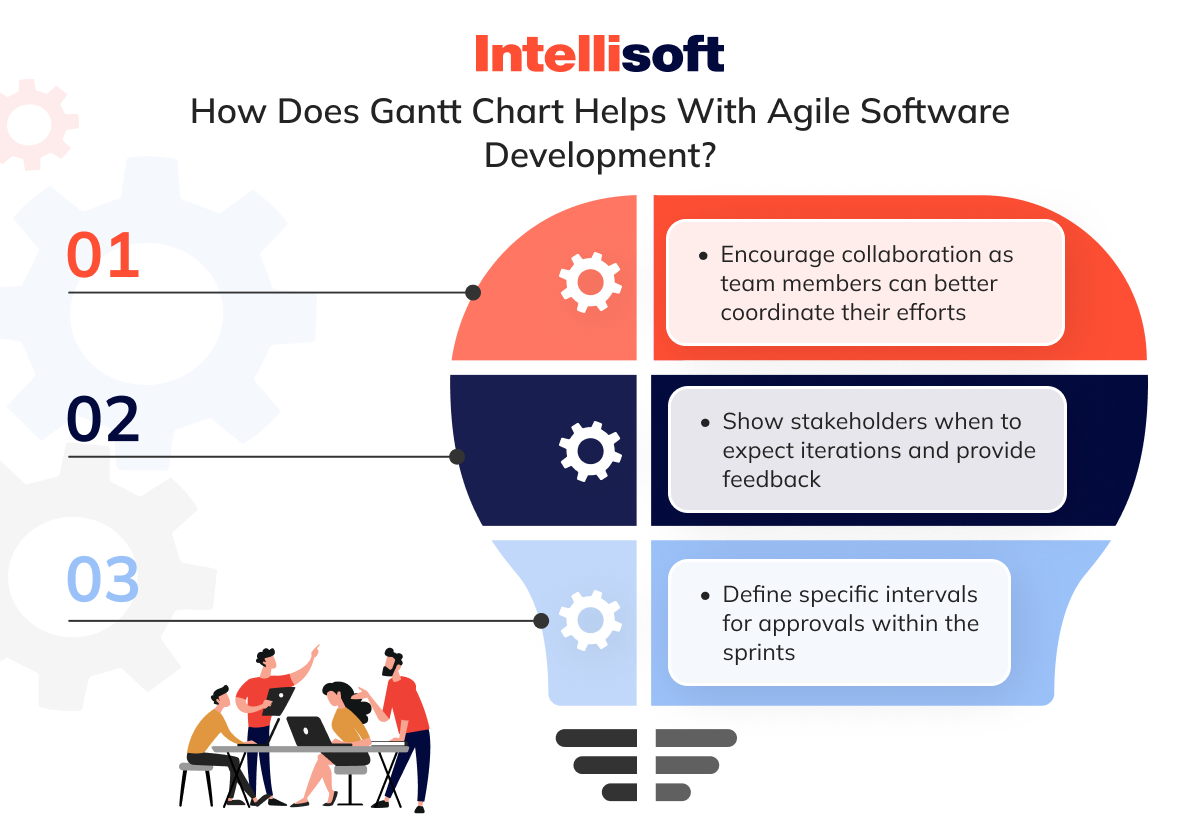
- Encourage collaboration as team members can better coordinate their efforts
- Show stakeholders when to expect iterations and provide feedback
- Define specific intervals for approvals within the sprints
Purpose and Objective of a Software Development Plan
The SDP Software Development Plan aims to effectively communicate to team members and stakeholders the chosen approach for developing software and the specific method that a Project Manager will use to allocate and manage resources.
The SDP aims to provide a comprehensive framework that enables a clear understanding of the software development process and the challenges that must be addressed. This framework should address a broad range of issues and questions that arise during development, such as:
- What problems are we solving?
- What are the primary tasks in development?
- Which software development methodology will we use?
- What are the critical functions?
- What is the development schedule?
- In what order will development proceed?
- What are the responsibilities of the team?
- How do we implement and measure quality control?
Software Development Plan Template
Utilizing a template for software development plan can significantly benefit the creation of a Software Development Plan. These templates offer a pre-structured framework, saving you time and effort. It also provides a consistent format that prompts you to cover essential aspects, ensuring you don’t overlook any crucial details. To illustrate this further, let’s look at a software development project plan template below.
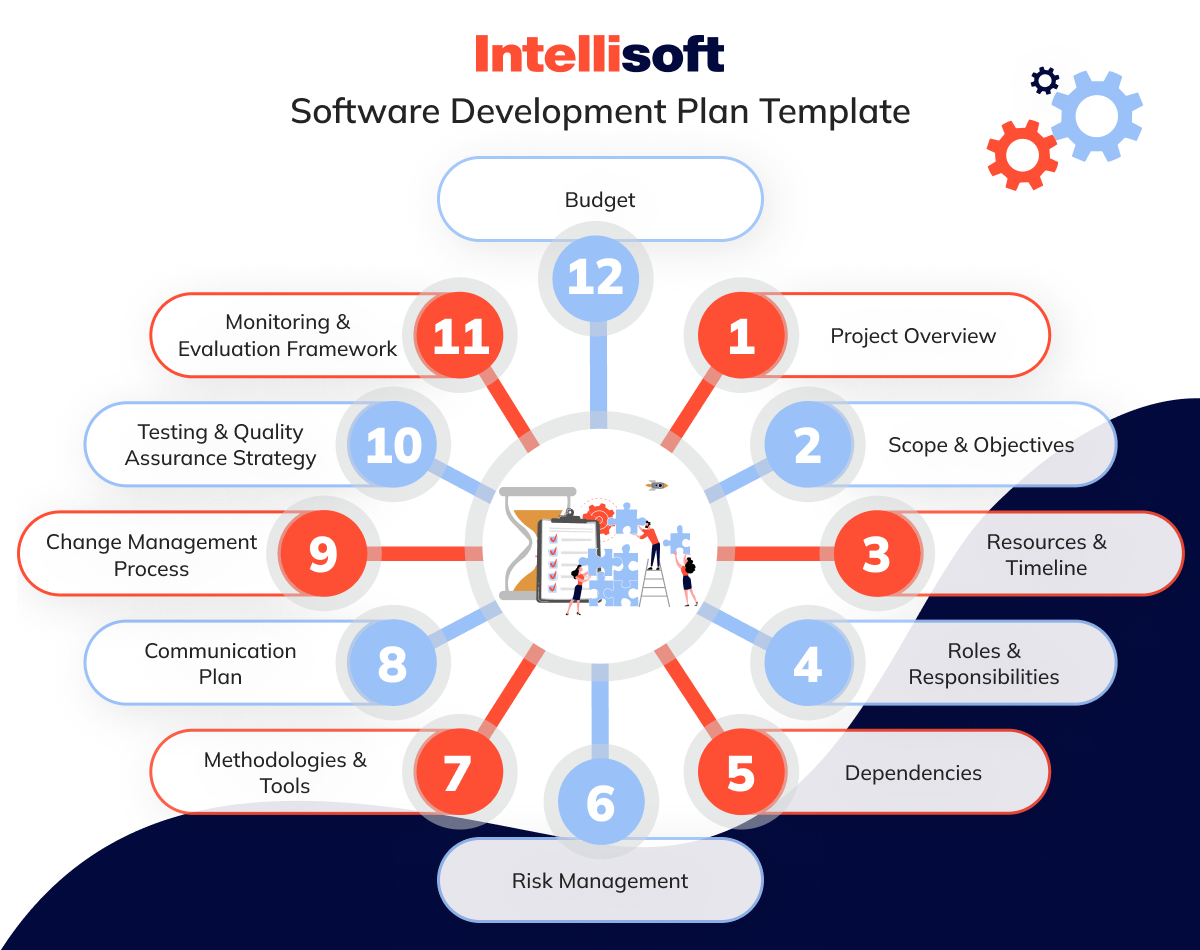
Project Overview
Deliver a comprehensive introduction that outlines its purpose, objectives, and scope. This step sets the stage for the entire development plan template and ensures a clear understanding of the project’s context. A well-written introduction should provide a detailed overview of the goals, including the specific outcomes you aim to achieve. It should also define the project’s scope, outlining the tasks and deliverables included and excluded from the plan. Lastly, the introduction should highlight the software development importance, explaining why it’s necessary to undertake this initiative and what benefits it will bring to the organization or stakeholders involved. By providing a detailed introduction, you can establish a shared understanding of the project and set the foundation for its successful execution.
Scope & Objectives
Provide a detailed understanding of what the software aims to achieve. This part of the business development plan template includes a comprehensive list of the software’s capabilities and how they will benefit the end-users. Ensuring alignment among all team members and stakeholders involved in the project is also essential. You can achieve this by clearly articulating the software’s purpose, objectives, and expected outcomes. Moreover, it’s crucial to consider any potential challenges during the software development process and establish a plan to mitigate them. By providing a detailed overview of the software’s features, functionalities, and goals, all team members will clearly understand expectations and how to contribute to success.
Resources & Timeline
To ensure successful project execution, identifying all required resources is crucial. It includes:
- Personnel
- Tools
- Technologies needed
Setting realistic timelines for each development phase is crucial while considering the task’s complexity and dependencies. A thorough analysis of each phase of the project can help identify potential roadblocks and bottlenecks, which can then be addressed proactively to ensure a seamless project execution.
Roles & Responsibilities
Assign specific roles and responsibilities to each team member based on their skills and expertise. This approach involves evaluating each team member’s strengths and weaknesses and identifying which tasks would be best suited to their abilities. Once the roles are assigned, it is crucial to clearly define who is responsible for each aspect of the project, including the tasks, deadlines, and deliverables. This approach helps ensure everyone knows what they are responsible for and can work together efficiently towards the project’s successful completion. By taking a proactive approach to role assignment, you can ensure that each team member is fully engaged and motivated to achieve the project goals, leading to a successful outcome.
Dependencies
Outlining the interrelationships between various project tasks is crucial when creating a project plan software development. It involves identifying and mapping out the dependencies between tasks, highlighting the ones that rely on the completion of others. This approach helps to ensure a clear understanding of the sequence of activities required to complete the project successfully. Doing so facilitates smooth project progression, allowing for better control and management of project timelines, resources, and risks. Understanding the interrelationships between project tasks is like creating a roadmap guiding the development team toward achieving project goals and delivering quality outcomes.
Risk Management
Before commencing a project, it is crucial to identify potential risks and challenges that may arise during the project lifecycle. These risks can range from technical issues and resource constraints to unexpected events such as:
Natural disasters
Regulatory changes
Economic downturns
By identifying these risks upfront, you can develop strategies to mitigate them effectively, ensuring proactive management and minimizing potential disruptions.
Methodologies & Tools
Detail the specific methodologies, frameworks, tools, and tech stack required for the project. This method includes outlining the specific processes, procedures, and practices that will be followed and identifying any relevant industry standards or best practices that will be incorporated. Additionally, it may be necessary to identify any specific tools or technologies that will facilitate communication, collaboration, project management, and any training or support provided to team members to ensure they can use these resources properly. By clearly defining and documenting these processes and tools, the team can work more efficiently and effectively, leading to better outcomes for the project as a whole.
Communication Plan
To facilitate effective coordination and maintain transparency with team members, stakeholders, and other relevant parties, establishing a clear communication plan is crucial. This plan should detail the methods and frequency of communication for distributing information and updates about the project. Common communication methods include emails, phone calls, instant messaging, and video conferencing. The frequency of communication—whether daily, weekly, or monthly—should align with the project’s requirements and the stakeholders’ level of engagement
Change Management Process
When it comes to project management, you should have a well-defined comprehension of the scope, objectives, and timelines to achieve the desired results. Nonetheless, it’s common for changes to surface during the project lifecycle that might influence these factors. Hence, setting up a robust process to manage and authorize any changes to project scope, objectives, or timeline becomes imperative to avoid scope creep and ensure that any modifications are controlled and streamlined.
Testing & Quality Assurance Strategy
Develop a comprehensive and detailed strategy for evaluating the software across three critical dimensions:
- Functionality
- Performance
- Reliability
Begin by defining specific testing methodologies that are appropriate for each aspect. For functional testing, consider using automated test suites that cover all potential use cases to ensure every feature behaves as expected. For performance testing, employ tools like load simulators and benchmarking software to assess the software’s response times and stability under various stress conditions. Reliability testing should include repeated execution cycles and recovery tests to evaluate the software’s robustness and error-handling capabilities.
Monitoring & Evaluation Framework
Establish a set of key performance indicators (KPIs) and metrics that can help assess ongoing success and user satisfaction. Carefully choose these indicators and metrics based on the software’s goals and objectives, as well as the needs and expectations of its users. Some common indicators and metrics include system availability, response time, error rates, user adoption, and customer satisfaction. Automated tools and manual testing are recommended to collect data and analyze the results. By regularly monitoring and evaluating the software’s performance, you can identify potential issues and areas for improvement and take proactive measures to ensure high quality and user experience.
Budget
To ensure the successful execution of the project, outlining the financial resources required in detail is critical. This approach to creating a software development company business plan includes anticipated expenses related to personnel, such as salaries, benefits, and training costs. It also involves the costs of acquiring the necessary tools and technologies required for the project and the expenses related to developing and maintaining the required infrastructure. Additionally, any other development costs, such as legal fees or marketing expenses, should be considered while outlining the necessary financial resources for the SDP Software Development Plan.
Related articles:
- Why Does Your Tech Start-up Need a Business Plan and How to Create One?
- Product Requirements Document (PRD) – Why Make It Lean?
- What is a secure software development life cycle?
- Guide to Software Requirements Specification
- What is low-code development and who can benefit from it?
How To Create A Software Development Plan Template: Step-By-Step Guide
If you’re planning a software development project, you’ll need to include several key phases in your plan.
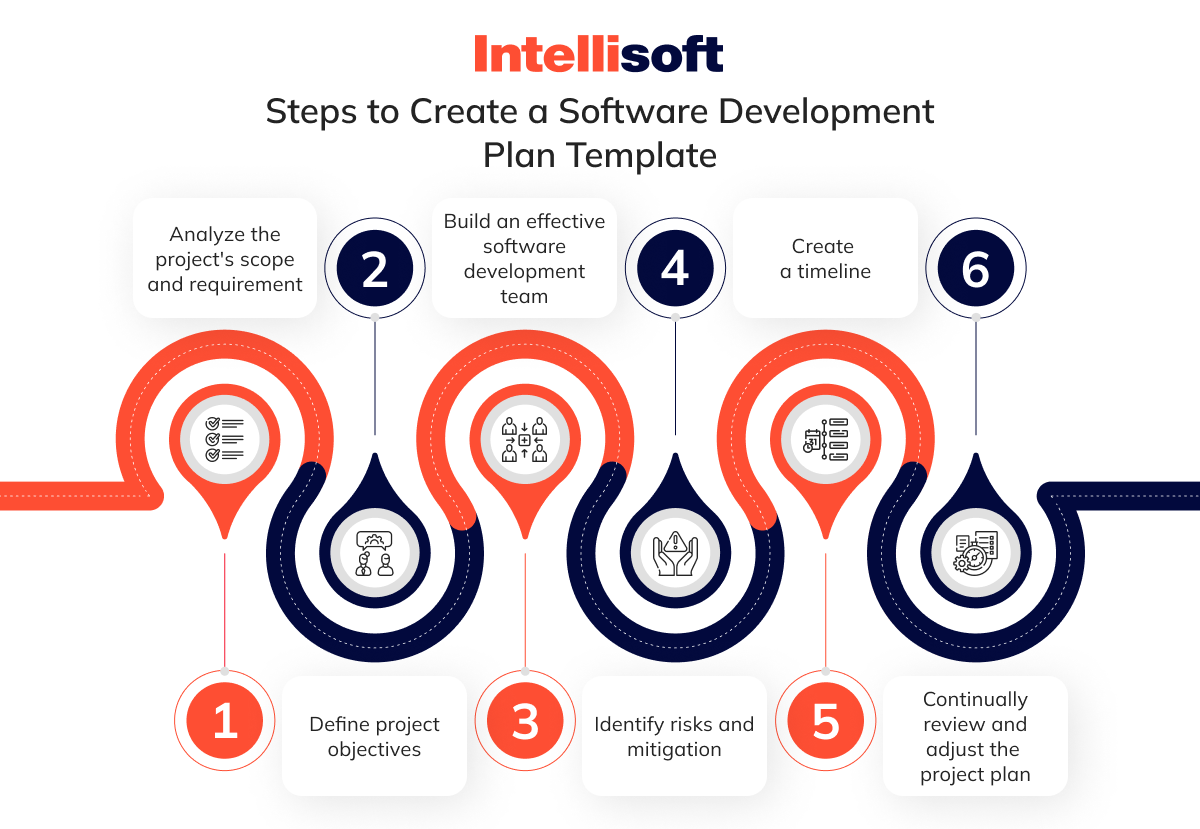
Analyze the project’s scope and requirement
Carefully analyze the requirements put forth by the client. This approach involves a thorough understanding of the client’s needs, goals, and expectations for the project and any constraints or limitations that may impact the implementation process. Some critical factors to consider during this analysis include:
- Alignment. How well do the client’s needs and requests align with the company’s capabilities and expertise?
- Resources. Does the company possess the necessary infrastructure, personnel, technology stacks, and time to meet the project’s objectives?
- Budget. What pricing model and budget has the client proposed for this software development project? Are these in line with the company’s financial expectations and resource allocation?
Define project objectives
After creating the software development requirements management plan, the next crucial step is to establish the project’s goals and objectives. A clear and well-defined objective is essential as it aligns the team’s efforts toward achieving a common purpose. A clear objective guides the software development process, ensuring everyone is focused and on track to achieve the desired outcome.
Following the SMART criteria formula is useful for refining the project’s objectives into actionable steps. This approach involves setting Specific, Measurable, Achievable, Relevant, and Time-bound goals. By adhering to this methodology, the project team can create concrete objectives that are both achievable and relevant. This approach helps avoid misunderstandings and ensures everyone works towards the same goal, leading to a successful outcome.
Build an effective software development team
Step 3 in software development involves building a well-equipped development team to handle the project’s scope and meet customer expectations. This step is crucial, especially in Waterfall or Scrum projects, as it determines the project’s overall success in quality and timely delivery.
In agile software development, the team is typically divided into smaller independent units that focus on distinct phases of the development process. On the other hand, in specific scenarios, the project may require the involvement of an outsourced team for particular tasks. Therefore, it is imperative to identify all the involved stakeholders in this step. If your team has never worked with an external team before, there are several reliable offshore software development companies that you can consider.
Lastly, after forming the complete team, assigning a project manager who can efficiently manage it is essential. The ideal project manager should have prior experience in a similar or relevant project type and in-depth domain knowledge. With a skilled and capable team, the project is well-positioned to succeed.
Identify risks and mitigation
When working on a software development project that involves multiple parties, such as clients, developers, and stakeholders, you should identify potential challenges and create a mitigation plan accordingly. A thorough software development startup business plan should cover end-to-end production stages, including:
- Development
- Testing
- UI/UX design
- System integration
- Product launch
To manage risk effectively, your team can use popular tools such as the risk matrix, also known as a probability and severity risk matrix. This tool can help you identify all possible issues, demonstrate the probability of a problem occurring, and predict its consequences.
If outsourcing your software development project, you should ensure that the team you are delegating it to is qualified with risk management certifications. This approach will help you mitigate and eliminate risk throughout the software development.
At IntelliSoft, we understand the importance of risk management in software development. Our ISO 9001:2015 certification ensures that all our project managers and technical leaders know how to create a software development risk management plan for risk mitigation throughout the project.
Create a timeline
When working on a software development project, it is crucial to create a well-planned timeline with realistic deadlines and milestones. This helps to set clear expectations and allows for easy monitoring and tracking of progress.
Milestones are key events or phases within the development process, such as completing the design phase or delivering the MVP version. They help determine tentative deadlines, which enable clients, stakeholders, and the internal team to keep track of the software delivery timeline effectively.
However, before finalizing the project timeline, you should get agreement from all team members. Any suggestions or feedback from team members on extending deadlines, using new tools or technologies, etc., should be discussed and agreed upon before initiating the project. This approach ensures that no unexpected incidents may disrupt the software development process and helps maintain a smooth and efficient workflow.
Continually review and adjust the project plan
Tech companies should be flexible and adaptable to stay ahead of the competition. While the Agile software development plan may appear linear, project managers and team leaders should collect and analyze project data regularly to ensure that the plan runs smoothly and efficiently.
However, this analysis requires a solid metric to track and evaluate the project’s performance and quality. Without these metrics and measurements, collecting useful data to make informed decisions and manage the project effectively becomes challenging. Therefore, you should have a reliable tracking system that can provide valuable insights into the project’s progress and help make necessary adjustments to enhance efficiency.
What To Avoid When Creating A Software Development Plan?
Planning and executing software development projects can be a complex and daunting task. It requires careful planning, attention to detail, and a deep understanding of potential risks and challenges that can arise during development. Failure to identify and mitigate these risks can lead to missed deadlines, increased costs, and reduced final product quality, so you should know the factors that can lead to this.
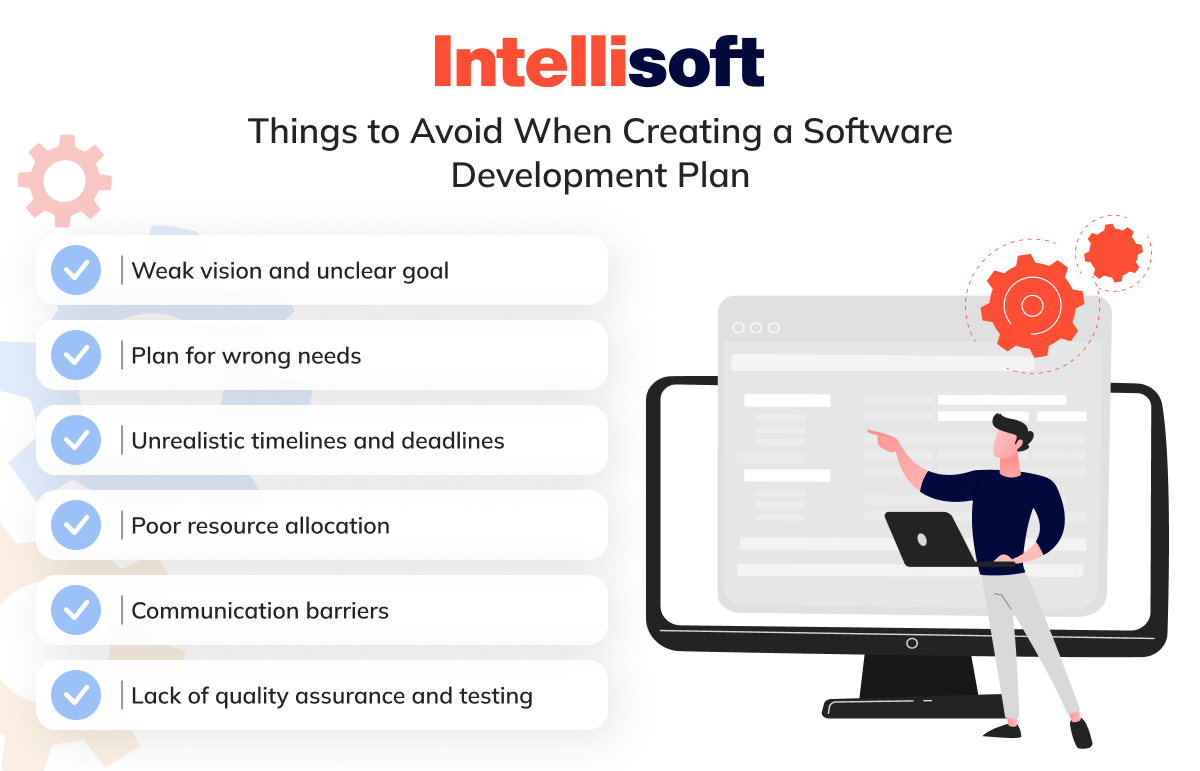
Weak vision and unclear goal
Having a clear goal and vision is crucial to achieving success in product development. Beginning with a vague idea can lead to confusion and a lack of direction for the team, which can ultimately fail. Therefore, you should establish a clear and concise strategy from the outset. This approach ensures that the development process stays on track and leads to a successful outcome.
Plan for wrong needs
In software development, each project is initiated to resolve a particular issue or challenge. However, as the project progresses and new obstacles arise, it becomes crucial to modify the development approach to meet the latest requirements. By making necessary adjustments and adapting to the latest needs, software development teams can ensure that their end product is effective and capable of addressing the latest challenges.
Unrealistic timelines and deadlines
Setting unrealistic deadlines or impractical timeframes for completing a project can create unnecessary pressure and stress for everyone involved. This pressure can lead to a rushed development process, which often results in a decline in the quality of the final product. You need to take the time to carefully plan and schedule projects to ensure that the development team can deliver high-quality work that meets intended standards.
Poor resource allocation
Efficient resource allocation, including proper utilization of tools, competent personnel, and suitable equipment, plays a critical role in ensuring the timely completion of a project. Inadequate resource allocation can lead to delays, decreased productivity, and quality issues, adversely impacting the project’s success. Therefore, precise and careful resource allocation is the key to meeting the project’s requirements and delivering expected outcomes.
Communication barriers
Effective communication is essential for a team project’s success. However, when team members fail to use proper communication strategies and tools, it can disrupt the workflow. This approach can give rise to misunderstandings and conflicts, which can further result in delays in project progress. Ultimately, these issues can slow the project’s pace, undermine the team’s morale, and jeopardize the project’s overall success.
Lack of quality assurance and testing
Developing a software application requires a well-thought-out plan that includes various crucial elements such as testing, code reviews, and quality assurance metrics. These components play a pivotal role in ensuring the success of the software development project. Neglecting these essential factors can result in unexpected expenses, project delays, and a subpar user experience. Inadequate testing and quality assurance measures can lead to system issues and software bugs, which can have severe consequences, such as project overruns and reputational damage for the company. Therefore, it is imperative to prioritize comprehensive testing and quality assurance measures to guarantee a successful software development project.
Build Your Development Team With IntelliSoft
A well-structured software development project plan is vital to ensure that your project runs smoothly. This approach simplifies communication and project management, resulting in superior outcomes. For seamless execution, consider hiring IntelliSoft.
What sets us apart is the ability to connect businesses with highly skilled developers who have been rigorously vetted for technical expertise, soft skills, and English proficiency. Our developers are not only highly qualified but also time zone-aligned, making collaboration a breeze. We also understand the hassle of hiring new talent, so we offer a comprehensive suite of services ranging from onboarding to payroll, benefits administration, taxes, and local compliance.
Continuous support is crucial for developer engagement and commitment, so we provide ongoing assistance even after the hiring process. Contact us if you’re interested in gaining access to top talent and enhancing your software development journey.






